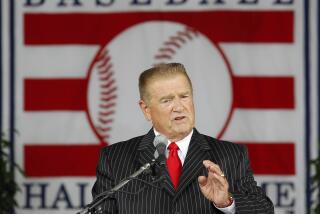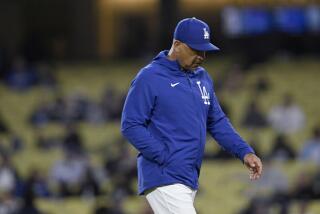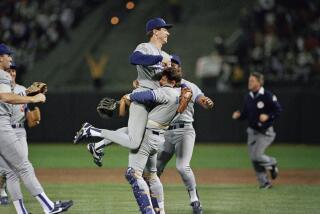They Called It a Case of Old Age
NEW YORK — To read the newspapers of 50 years ago, Lou Gehrig’s dramatic decline in the 1938-39 seasons was simply a case of old age.
“Old Iron Horse Not What He Used To Be” declared a Sporting News headline in June, 1938, referring to the 35-year-old first baseman’s slow start in the season before his career ended.
With Gehrig’s batting average hovering around .280 -- 60 points below his lifetime mark -- Dan Daniel, who covered the Yankees for The Sporting News and the New York World Telegram, sadly noted that the first baseman “can not get the old swing, he can not put the old driving power on a ball.”
While John Drebinger of The New York Times was slower to criticize “The Old Iron Horse,” he still could not avoid the issue of Gehrig’s age. After the first baseman broke out of a slump with two homers against the Philadelphia Athletics on Aug. 14, the writer observed:
“Folks who gather on the east bank of Harlem have taken sort of a second liking to him.
“After all, the Iron Horse is getting old, he is always doing his best and it isn’t exactly sporty to ride a fellow merely because the years have caught up with him.”
The self-effacing Gehrig was popular with all the writers, especially the New York Evening Post’s Harold Burr, who referred to the first baseman as “Locomotive Lou” and “Old Rawhide.” But Gehrig’s poor spring in 1939 forced the writer to observe that “The game has a habit of catching up even with its men of galvanized iron . . . The old mills of the gods keep grinding and they play no favorites.”
Until 1938, Gehrig seemed indestructible. He had not missed a game since 1925 and looked better than ever in 1937, batting .354 with 49 homers and 152 RBI.
Drebinger likened Gehrig’s durability to “the tumbling waters of Niagara.” Writers and fellow players marvelled at the first baseman’s superb condition, which Gehrig attributed to avoiding late night raids on the icebox and limiting snacks to apples and stewed fruit.
A line drive against the Tigers once prompted Burr to rave that “The Locomotive’s single was hit so hard the crowd gasped as it went whining over Hank Greenberg’s head.”
When ex-Yankee Everett Scott, whose string of 1,307 consecutive games had long been shattered by Gehrig, warned his former teammate that the streak “was shortening his career and life,” the first baseman laughed off the advice, vowing to play 2,500 straight games.
Daniel was more skeptical. “Suppose Gehrig begins to show he is 35,” the writer worried at the start of the 1938 season. Despite a mediocre first half, Gehrig was again named to the American League All-Star team, but Daniel ranked him fourth among first basemen, behind Boston’s Jimmie Foxx, Detroit’s Hank Greenberg and Cleveland’s Hal Trosky.
In the July 28 issue of The Sporting News, Daniel gave a bleak assessment of Gehrig’s performance:
“Gehrig has been in a long and seemingly hopeless slump ... We hope he can rally. But he just can’t keep going consistently once he does right himself. It is my conviction that Gehrig is a very tired man.”
Drebinger looked for hopeful signs wherever possible.
“Herr Gehrig got himself into a terrific heat,” Drebinger noted approvingly of an argument Gehrig had with the first base umpire in a game on July 30.
“Our placid Squire of Larchmont looked like the Tarzan of old as he beat himself on the chest and pounded the ball into the ground.”
Even an intentional walk was inspiration for Drebinger. When the Detroit Tigers chose to pitch around Gehrig in an Aug. 31 game, the writer concluded that “rival pilots have become fully cognizant that Gehrig is belting the ball as of old.”
Rud Rennie of the New York Herald Tribune believed that Gehrig’s troubles were caused by an improper batting stance. In the Aug. 9, 1938, edition of the Tribune, Rennie noted that Gehrig, a left-handed batter, had been planting his right foot at an angle toward first but was now standing “squarely at the plate,” resulting in a “blinding flash of his old power.”
Gehrig finished 1938 with a .294 average, 29 home runs and 114 RBI, below his peak production but still respectable enough to give encouragement to his admirers in the press. “Some day I suppose, Gehrig will collapse . . . ,” Tribune columnist Richards Vidmer observed at the end of the season, “but that day seems a long way off.”
The first baseman had always been a slow starter but Gehrig played especially poorly in the spring of 1939, managing just four hits in his first 35 at-bats and committing five errors in 10 games.
James P. Dawson of the Times wrote on March 22 that the first baseman “is not even a shadow of the Gehrig that he was.”
Daniel added that “Gehrig’s legs seem to bother him. He looks harrassed. Training has been a terrible grind for the Iron Horse this year.”
More to Read
Go beyond the scoreboard
Get the latest on L.A.'s teams in the daily Sports Report newsletter.
You may occasionally receive promotional content from the Los Angeles Times.










